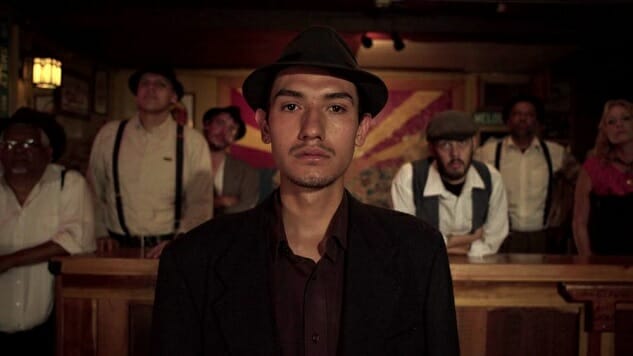
Robert Greene opens his essential new documentary, Bisbee ’17, with a quote from American writer Colin Dickey’s 2016 book, Ghostland: “Cities that are haunted … seem to straddle past and present as though two versions of the same city are overlaid on top of each other.” He’s talking about haunted manors littering the United States specifically and not the Arizona burg of Bisbee, but the town Greene acquaints us with indeed straddles its past and present, and something more—a collision between the two in the form of theater.
Greene provides background on Bisbee’s significance with his opening scrawl, a history lesson set against a blood-red background. In 1917, at the height of World War I, Bisbee was a critical hub in the war effort, not just a copper town but the copper town churning out minerals and profits. Then the miners went on strike, demanding safer work conditions and railing against campwide discrimination. To quash protests, Bisbee’s sheriff deputized a small army of locals, rounded up strikers in the early morning of July 12th, stuck them on cattle cars, and dropped them off in the New Mexico desert in an effort by the Phelps Dodge mining company and Bisbee’s law to halt dissent and restore order to their bottom line.
Greene comes into the story 100 years later, as Bisbee’s current residents, prepping for the Bisbee Deportation’s centennial, decide they must recognize the evils of Bisbee yesteryear. How best to do so? By putting on a reenactment, casting townsfolk as miners, as the sheriff’s posse, as witnesses to the travesty. This is Greene’s jam: See, for instance, Kate Plays Christine, his 2016 collaboration with actress Kate Lyn Sheil, in which they together reenact the 1974 on-air suicide of reporter Christine Chubbuck. There are also the movies of Joshua Oppenheimer—The Act of Killing and The Look of Silence—which explore past horrors but with the added benefit of the involvement of their perpetrators. Greene may lack the actual participants, but he does have a town aware of its history along with descendants of the deportation’s principal actors from both sides of the event.
“Both sides.” That’s a key phrase in Bisbee ’17, a film not so much interested in damning the sin but attempting to understand the sinner. Greene’s chronicle of the reenactment, and his portraits of Bisbee’s citizens, eschews judgment for a painful examination of transgressions, not one’s own transgressions but the transgressions of their forebears. Take the Ray family, Mel and Steve, cast as their grandfather and great-uncle; the former, during the days of the deportation, arrested the latter, acting out of duty over familial obligation. Or take Richard Hodges, a benign, kindly man who recalls his days at Bisbee’s high school in 1969, and invests himself fully into the character of Harry Wheeler, the sheriff running lead in the deportation. You or I might step into Wheeler’s skin interpreting him solely as a villain, but Hodges does much more difficult work of figuring out Wheeler as a person.
Hodges sees Wheeler as a man who, in the spirit of the banality of evil, thought he was doing the right thing. But Bisbee ’17 also drives home that Wheeler was Phelps Dodge’s lackey. But to Hodges, that’s just fine: To paraphrase him, Hodges wouldn’t have played Wheeler if Wheeler wasn’t a complicated man. The sentiment is overwhelming enough to justify the exercise all on its own. It’s easy to look back at history to pass sentence on its guilty parties. Bisbee ’17 isn’t so magnanimous that it avoids drawing conclusions about blame and culpability—by the end of the film, even the people who make the “both sides” equivocations grant that what happened never should have—but Greene and his Bisbee colleagues are in pursuit of something considerably more complex than assessments of past wrongs. Of course the deportation was wrong. What the film tries to understand is how those wrongs came to be, and in understanding, perhaps heal old wounds.
Greene blends traditional documentary techniques, talking head interviews and appraisals of primary sources, with the artifice of feature narrative: There’s a superb tracking shot fifteen or so minutes into the film that follows Fernando Serrano, a young Mexican-American chap with little to zero interest in or awareness of the deportation, but who goes on to find catharsis in the reenactment all the same. The shot travels from the noodle shop where he works, through the doors of Bisbee Realty, through yet another set of doors leading into an empty old theater, and onto the stage, where he announces himself to an audience of dust particles. Greene’s craftsmanship invites awe as easily as the reenactment itself, scrappy but successfully harrowing in execution. The players get into their roles with more than professional enthusiasm—their performances exhibit a relish and zeal both shaped by an underlying desperation to observe the truth when for so long Bisbee has lived with truth unspoken as well as with lies.
Bisbee ’17 visits its location’s haunted atmosphere on the viewer. As the crimes of the deportation haunts Bisbee and its inhabitants, so, too, are we haunted by them through the filter of Greene’s lens. But that experience, the experience of being haunted, proves vital. Maybe it’s necessary to let history haunt us. If we don’t, we’ll never be able to move beyond it.
Director: Robert Greene
Writer: Robert Greene
Starring: Fernando Serrano, Richard Hodges, Mel Ray, Steve Ray, Doug Graeme, Dick Graeme
Release Date: September 5, 2018 (limited); September 28, 2018 (wide)
Boston-based culture writer Andy Crump has been writing about film and television online since 2009 (and music since 2018). You can follow him on Twitter and find his collected writing at his personal blog. He is composed of roughly 65% craft beer.